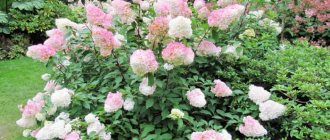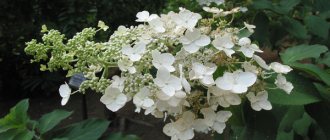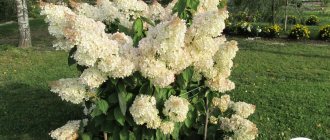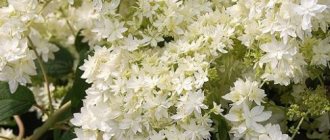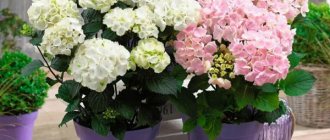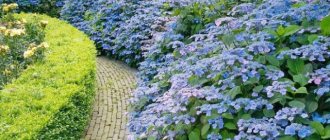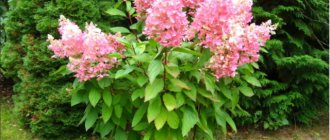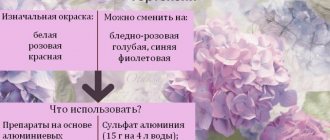The best varieties of paniculata hydrangea for Siberia
The varietal variety of paniculate hydrangeas is optimal for agricultural technology at low temperatures, since these flowers are characterized by good frost resistance. Moreover, their impressive size, elongated inflorescences and attractive colors are widely popular in decorating parks and garden areas.
Did you know? The Japanese call hydrangea the word Ajisai, which translates as “a flower that resembles the purple sun.”
Flower growers in Siberia are recommended to give preference to the following varieties of paniculate flowers:
- Vanilla Fresh;
- Bobo;
- Limelight;
- Medical Flute;
- Pink Diamond;
- Sunday Fresh;
- Medical Fire.
Bobo, Vanilla and Sandai Fresh are dwarf varietal varieties, growing no more than one meter in height. All others can form impressive shrubs, up to 10 m high.
Basic subtleties of pruning
First year
Immediately after spring planting, the growths must be shortened by one or two strong buds and weak shoots cut out. Among the strong growths and side branches that have grown over the summer, only those growing inside the bush and the weakest ones are pruned.
Second year
When flowering ends, strong branches grow at the bottom of the bush, which must be shortened to the lower new strong growths.
Third year and beyond
After flowering ends, all faded branches are cut down to the lower strong growths, weak ones are removed. A very dense bush needs to be thinned out by removing some old branches.
Considering the peculiarity of large-leaved hydrangeas to bloom on last year's shoots, at the end of July it is necessary to cut off the old inflorescences along with four leaves. After all, in August the buds of next year are laid, and if you are late with pruning the bush or do it too radically, then next year it will not bloom.
If, unfortunately, the above-ground part of the hydrangea is frozen, there is no need to despair right away. Cut all branches short, then active growth of young branches from the lower buds will begin.
Landing
The procedure for planting a crop in Siberia will not require much effort from the gardener, since it includes the same steps as with any other flower, namely, choosing a planting site, digging and preparing a hole.
Important! Do not plant hydrangea on alkaline soils, as it will take root poorly and grow slowly.
Its decorative qualities will also suffer
Selecting a location
Hydrangea has its own requirements for the planting site. The place must be protected from piercing Siberian winds and drafts. Panicle varieties do not like direct sunlight, so they need to be provided with growing conditions in partial shade. Open areas should be avoided. It is best to choose places for culture under walls or fences.
As for the type of soil, preference should be given to slightly or moderately acidic soils, which should include turf soil, peat, humus, leaves and sand. Adding pine needles to the hole will help increase the acidity of the soil.
Also find out what kind of soil is needed for planting garden hydrangea.
Pit preparation
After choosing a site, you should start preparing the hole, which includes the following steps:
- Direct digging. If the seedlings are of medium size, then the parameters of the planting holes should be 50x50 cm, for large seedlings - 80x80 cm. The standard depth is 60 cm.
- Filling the hole with water. Each will require 3 buckets. All this is left for one night so that the liquid is completely absorbed into the ground.
- Substrate preparation. The nutritious soil mixture should include parts of turf soil, humus, sand, peat in proportions of 2:2:1:1 and fertilizers (20 g of urea, 20 g of potassium and 60 g of superphosphate).
- Preparing a seedling for planting. The shoots are cut to the level of 5-6 buds, and small roots are also shortened.
- Place the seedling in a new location and fill the hole with substrate. The root collar of the plant should be above the top soil layer.
Transplantation after purchase into open ground in Siberia
It is better to buy and replant crops in the spring; the specific timing depends on the temperature indicators of the region. Planting hydrangea in spring in open ground in Siberia takes place from the last week of April to the first week of May.
Planting hydrangeas in the ground is recommended in the spring.
What is needed for planting
The culture requires soil consisting of 2 parts peat and 1 part river sand and humus. To increase acidity, pine needles are added. Planting holes are spaced at a distance of 60 cm, for small specimens - 50x50 cm, for large ones - 80x80 cm.
Plant care
Caring for hydrangea in Siberia is essentially no different from growing it in any other regions. Mandatory items are watering, mulching the tree trunk, pruning and fertilizing procedures.
Watering
The flower in question is extremely fond of moisture, and therefore needs regular watering. As a rule, hydrangea is watered twice every 7 days. The gardener must ensure that the soil around the hydrangea is always moist. So, if the weather remains dry outside for a long time, then it is worth moisturizing the crop daily. The optimal amount of liquid for one plant is 10 liters.
Important! Hydrangea will delight you with its especially lush and spectacular inflorescences if you periodically (for example, once every 2 weeks) add potassium permanganate (1 g per 1 liter) to the watering liquid.
The shrub also makes special demands on the quality of water: it must be soft - hard water will have a bad effect on the life of the plant, so it is best to use rain, melt, settled or filtered water for this purpose. Vinegar (about 5 tbsp per bucket) or lemon juice squeezed from one citrus fruit for 10 liters of water will help soften the liquid.
Mulching
Covering the soil with mulch is a mandatory measure for caring for paniculate varietal varieties of crops growing in Siberia, since mulch is responsible for the function of preserving moisture in the soil layer. It is recommended to mulch the soil around the plant trunk using wood chips, peat chips, pine needles or leaves. The mulch layer should be about 10 cm thick.
Trimming
Giving paniculate varieties of hydrangea a good decorative shape is done through regular pruning. Spring procedures consist of shortening last year's shoots by a third of their length. Damaged, weak branches, as well as those that grow inside the bush, are completely eliminated.
Important! Until the plant is 3-4 years old, pruning it is prohibited.
Young people should not be touched. In the fall, it is worth removing all the inflorescences that have bloomed. If the shrub is no longer young, then in autumn all its shoots need to be shortened so that their length does not exceed 5-6 cm above the soil level.
Feeding
In order for the plant to feel good, grow well and bloom profusely, it must be fertilized regularly.
We recommend reading about diseases and pests of paniculate hydrangea and methods of combating them.
If in warm regions fertilizing is applied twice per season, then in harsh Siberian conditions the plant must be fed 4 times:
- In early spring, approximately the beginning - mid-May. For every 1 m² of area, urea (20–25 g), superphosphate (about 30 g) and potassium sulfate (20 g) are added. After 2 weeks, fertilization with these substances is repeated.
- During the budding period. The crop is fed simultaneously with watering. Superphosphate (70–80 g) and potassium sulfate (about 50 g) are diluted in 10 liters of water and the shrubs are watered with this nutrient solution.
- After flowering, a certain amount of manure or humus (6-7 kg) is placed under each bush.
Possible diseases and pests, ways to get rid of them
Hydrangea is quite resistant to diseases, but it can suffer from:
- White rot. This is a fungus that is found in the soil, so it primarily affects the root system of plants. Because of this, the plant cannot receive beneficial nutrients. To combat this fungus, Fitosporin or its analogues are used. The powder must be used very carefully, making sure to protect the eyes during treatment. Usually 20 g of Fitosporin dissolved in 10 liters of water is enough to protect hydrangea. To consolidate the result, it is worth repeating the treatment after 2 weeks.
- Gray rot. This disease affects the stems as well as the leaves of the plant. They become too soft and flaccid. In rainy summers, the grayish fluff on the bush is clearly visible, which is why the disease got its name. Gray mold can also develop during drought. In this case, parts of the plant will quickly dry out and fall off. To get rid of gray rot, you need to cut off all affected areas of the bush and burn them. After this, you can spray with Pure Flower or Fitosporin.
- Septoria. This is another fungal disease that can be identified by the presence of spots up to 6 mm in size on the leaves. Gradually they begin to increase and affect all the foliage. To get rid of this fungus, you need to destroy all infected leaves, and then spray the plants with copper-based compounds (for example, copper sulfate will do).
- Powdery mildew. It can be identified by the presence of yellowish-green spots on the leaves of the hydrangea. After some time, they begin to darken and acquire clearer lines. In the lower part of the foliage the color changes to purple or grayish. If you do nothing, the plants will shed all their leaves. Fitosporin or Alirin can also be used for treatment.
- Downy mildew. This disease can only appear during heavy rains or, conversely, during hot summers. In this case, the leaves become almost completely covered with unpleasant greasy spots and darken. To treat hydrangea, you need to mix 15 g of copper sulfate and 150 g of green soap in a bucket of clean warm water. After this, the bushes are sprayed.
- Rust. When this disease develops, unpleasant dark red spots appear on the leaves. This usually happens if there are too many hydrangea bushes growing nearby. Rust also develops from an excess of nitrogen in the soil. For treatment, a spray solution is usually used, which is prepared from 40 g of copper oxychloride diluted in a bucket of water. Some treat plants with specialized preparations, such as Topaz.
- Fusarium. This is another fungal disease that spreads through the soil and first affects the root system. If plants stop receiving the necessary nutrients due to the partial destruction of the rhizome, then the bushes die completely. To get rid of the disease, you need to soak 2 kg of nettle and celandine in 5 buckets of water and leave in this state for a day. After this, take one part of the infusion and mix it with 5 parts of water. The resulting solution should be watered over the hydrangeas.
- Chlorosis. The foliage of the plant begins to lighten, gradually turns yellow and falls off. As a rule, the disease appears when there is not enough iron in the soil. Chlorosis also affects the shape of leaves and buds; they become deformed, curl and dry out. To cure a bush, you need to fertilize it with compounds containing iron. For example, you can find a specialized drug called Anti-chlorosis on sale.
Hydrangea paniculata in Siberia (planting and care must be carried out according to all the rules) grows quite successfully. But if we talk about pests, they can also ruin the appearance of shrubs.
Most often, hydrangea is affected by:
- Leaf aphid. This is a tiny insect that is distinguished by its ability to reproduce quickly, which causes very serious damage to the flower, including its complete death. Aphids feed on plant juices and suck out nutrients, which leads to yellowing and drying of the foliage. To detect insects, you need to periodically inspect the back of the leaves. If a large concentration of these insects is detected, it is best to treat with insecticides. You can also stop the reproduction of aphids by attracting ladybugs and lacewings to the plant, from which aphids stay away. If the damage is not serious, and there are not many larvae, then you can limit yourself to treating with a soap solution.
- Spider mite. This is another small insect that, despite its size, can seriously damage flowers. It reproduces best in hot weather and low humidity. The tick weaves a web, which gradually spreads to the entire above-ground part of the bush. Because of this, the leaves begin to gradually wither, they curl and dry out. Akarina and Actofita are considered good remedies for spider mites.
- Root-knot nematode. This parasite primarily reproduces in the ground and actively infects plant rhizomes, releasing a toxic liquid. As a result, red galls are formed on the root system, which look more like blisters. They can also be found at the bottom of the stem. If the lesion is allowed to occur, the plant will die. If the damage is already quite serious, then it is better to get rid of the entire bush. To prevent the appearance of these insects, when transferring seedlings to the garden bed, it is recommended to treat the soil with Fitoverm.
- Slugs and snails. These pests primarily feed on foliage. They appear in heavy shade and high humidity. Slugs can be found in the axils of plants. After this, it is recommended to collect them by hand and destroy them. To prevent damage by these insects, it is imperative to mulch. Some also sprinkle crushed eggshells around the perimeter of flower beds.
Reproduction
The most popular methods of propagating paniculate hydrangea in Siberia are cuttings and sowing seeds. The first method is preferable, as it allows you to get results faster.
Did you know? Hortensia was named in honor of the sister of the French explorer,
Prince of Nassau-Siegen, who participated in a round-the-world expedition led by Louis Antoine de Bougainville. The prince kept telling his comrades about the indescribable beauty of his sister Hortense, so when they saw a lovely flower in the Mauritius Islands, they decided to name it after the girl.
Cuttings
It is preferable to carry out cuttings during the period when the plant is actively blooming. Leafy cuttings with two or three buds are cut from the bush. To do this, it is worth choosing side shoots from last year's growth. The petioles are placed in a growth stimulator (for example, Heteroauxin or Kornevin) for two hours.
Rooting should be carried out in open ground conditions, but it is recommended to cover future seedlings with film. For the winter, young plants are moved to a special container and then transported to closed, cool conditions. The seedling should be transplanted only in late spring of next year.
Seeds
Seed for cultivating hydrangea seedlings at home should be purchased at a specialized store.
Did you know? The blue color of hydrangea inflorescences is explained by the fact that the crop is able to absorb aluminum contained in acidic soils.
Next you need to follow the following steps:
- Before sowing, the purchased seed must be disinfected in a weak solution of potassium permanganate or copper sulfate.
- It is preferable to sow the seeds in February; they should be germinated first (put them on damp gauze or cotton wool and wait until they swell).
- While the seed is germinating, you need to prepare a substrate from equal parts of leaf soil, peat and sand. The substrate is placed in a container and seeds are placed on top of it, which are sprinkled with a little sand. Then the container is covered with film or glass.
- Twice a week, the planting material should be watered with a spray bottle, making sure that there is no excessive moisture.
- The first shoots will begin after 3-4 weeks. When the second leaves appear on the seedlings, they can be planted in separate containers.
- Only after 2 years can seedlings grown from seed be transplanted to a permanent location.
Transplantation into open ground
In order for the plant to delight with abundant, long-term flowering, it is important to know how to plant hydrangeas in spring in open ground in Siberia. It is at the stage of acquiring a seedling and planting it that aesthetic indicators, health and longevity are laid down. In areas of Siberia, Hydrangea is planted in open ground from late April to early May.
Young seedlings are very sensitive to return frosts. If you do not take into account the risk of temperature fluctuations, the plant may die. Therefore, you need to plant hydrangea in the soil with the beginning of sustainable warming. Young bushes can be purchased at special nurseries or from amateur gardeners.
Experts will help you choose the right variety. Shortly before purchase, it is worth testing the soil for acidity. Optimal soils for planting young bushes should have a slightly acidic or acidic reaction. Hydrangea does not tolerate alkaline soils at all.
Important! When purchasing a seedling, you must carefully examine the root system.
The roots of healthy specimens are light, quite elastic, and not brittle. The root system consists of small and large lignified roots.
Preparing for the Siberian winter
Preparing garden paniculate hydrangea for Siberian winters has its own characteristics. Even if you have planted the most frost-resistant variety of paniculate hydrangea on your site, it will not be able to survive the harsh Siberian winter if it is not covered and step-by-step procedures for preparing for the cold period are not carried out.
It may be useful for you to learn about planting hydrangeas in the Leningrad region.
Before the onset of frost and snow, you should take the following steps:
- Hilling up the plant with soil and mulching the tree trunk. It is recommended to use rotted manure, peat, pine needles, and dry leaves as mulch.
- Covering the bush with burlap or agrofibre. The branches of the plant should be bent to the ground and fixed. Then lay a layer of covering material, and sprinkle the so-called on top. heating materials (spruce branches, dry leaves, sawdust). For large bushes, it is worth forming a frame wire shelter - a kind of hut, which should rise 10 cm above the ground. The space in it is filled with leaves and covered with film.
- With the appearance of snow, it is worth making a snowdrift around the bush, which performs both protective and moisturizing functions.
So, hydrangeas can grow even in Siberia - you just need to provide this attractive garden flower with good care and follow all the rules of agricultural technology. In general, they are similar to those that operate in warm regions, they just have their own characteristics.
Secrets of agricultural technology
Hydrangeas have almost identical requirements for growing conditions. When growing hydrangeas, emphasis is placed on:
Important! Rotting the mulch increases the acidity of the soil and improves its structure.
Hydrangea blooms
Fertilizing of crops begins in the spring and ends at the height of the summer season:
Pest and disease control
If spider mites and aphids bother you, use insecticides:
When affected by chlorosis, iron-containing preparations are added during watering.
Kleschevit and Tiofos
How to survive winter without losses
However, despite the assurances of breeders and sellers that the plants are cold-resistant, the bush needs to be covered with the onset of winter.
In order for hydrangea to overwinter well, it is important:
The variety of hydrangeas will allow gardeners to make a worthy choice. Which varieties to choose and how to plant is a matter of personal taste.
Suitable species
Only some types of hydrangea can tolerate cold Siberian conditions, namely paniculate and tree-like ones. When choosing the right variety, it is very important to pay attention to its characteristics, especially the height of the bush, pay attention to the size of its inflorescences, as well as the flowering period. For northern regions, it is recommended to purchase early-blooming varieties of hydrangeas, since you simply won’t be able to admire the beauty of late blooms due to the onset of too early cold weather.
Paniculate hydrangeas have fairly large inflorescences that resemble a cone in shape. Whether you can admire the blooming of lush hydrangea or not depends on the correct choice of the required variety.
Today there are about thirty types of hydrangeas, most of which are simply unable to withstand severe frosts, which is why young plants should only be purchased from trusted gardeners.
